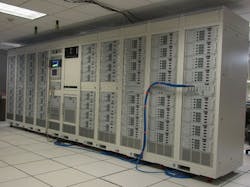Preparing the U.S. Navy’s F-35 fighter for use requires advanced testing techniques. In support of the fighter, Northrop Grumman has recreated mission-like conditions both in the test laboratory and on the operating range. Some of the firm’s most sophisticated EM simulators were recently delivered to the U.S. Navy and NAWCWD Point Mugu, including the Combat Electromagnetic Environment Simulator (CEESIM), the Signal Measurement System (SMS), and various other EM simulators, all under control of the Synchronizer Control System (SCS).
“Keeping the F-35’s systems ready requires a fully integrated test environment like we have developed with CEESIM, SMS, and SCS,” said Joe Downie, director, land and avionics C4ISR division, Northrop Grumman Mission Systems. “These systems work together to provide the environment complexity and density, measurement and analysis capability, and test control capability necessary to evaluate the F-35 in a realistic mission scenario.”
The F-35 involves advanced measurement techniques for evaluating a number of different radar and communications functions, and requires similarly advanced systems for adequate simulation.
The CEESIM simulator is at the center of the test environment, since it is capable of simulating multiple, simultaneous RF emitters as well as static and dynamic platform attributes to faithfully model true-to-war conditions. CEESIM’s Advanced Pulse Generation high-speed direct digital synthesizer technology is used to generate realistic electronic warfare mission scenarios. The SMS provides wide bandwidth signal measurement, recording and analysis capability to validate the test environment and evaluate the system under test performance.
The SCS provides the tools to program an integrated multispectral test scenario, including threat radars, communications signals, radar, and electro-optical/infrared (EO/IR) signatures. The SCS also manages the execution of the scenario by all of the simulators to ensure a coherent multispectral test environment.
About the Author
Jack Browne
Technical Contributor
Jack Browne, Technical Contributor, has worked in technical publishing for over 30 years. He managed the content and production of three technical journals while at the American Institute of Physics, including Medical Physics and the Journal of Vacuum Science & Technology. He has been a Publisher and Editor for Penton Media, started the firm’s Wireless Symposium & Exhibition trade show in 1993, and currently serves as Technical Contributor for that company's Microwaves & RF magazine. Browne, who holds a BS in Mathematics from City College of New York and BA degrees in English and Philosophy from Fordham University, is a member of the IEEE.


